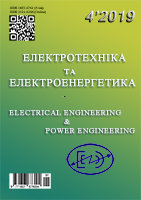THE STRUCTURE OF INFORMATION TECHNOLOGY FOR MANAGING PORTFOLIOS OF ENERGY SAVING PROJECTS AT METALLURGICAL ENTERPRISES
DOI:
https://doi.org/10.15588/1607-6761-2019-4-4Keywords:
investment, project portfolio, metallurgical enterprise, information technology, supplier energy saving, quality, criterion, reliability, supplier, indicatorAbstract
Purpose. In the implementation of investment projects, the process of industrial production, associated with the choice of the optimal supplier, customer, business partner; determining the best quality of products, minimizing the cost of purchasing and delivering material resources, etc.. This article analyzes the information technology of a software product to automate the decision support process in the financial investment activity of a metallurgical enterprise..
Methodology. To solve the optimization problems, the following methods were applied: methods of studying the functions of classical analysis; indefinite Lagrange multipliers; variational calculus; dynamic programming; maximum principle; linear programming; nonlinear programming..
Findings The designed system, helping to make the most effective, comprehensive solution, can reduce the intellectual burden on the decision maker, minimize the number of routine operations and complex mathematical and economic calculations and, as a consequence, significantly reduce the time for decision. The advantage of the considered software product is that it is able to solve simultaneously two urgent tasks for today - to form the optimal portfolio of securities and to choose the optimal supplier of resources. Thus, it is convenient for metallurgical enterprises and will reduce the cost of purchasing software.
Originality. This software product has no analogues at the moment, it is able to solve two current problems for today simultaneously - to form an optimal portfolio of securities, and to choose the optimal supplier, which will reduce the cost of purchasing materials and use these funds for the implementation of energy conservation projects at metallurgical enterprises
Practical value. The calculation method offered by the choice of the optimal supplier is universal and acceptable for the evaluation of enterprises in terms of different characteristics: the proposed methodology is based on a comprehensive, multidimensional approach to the evaluation of such complex phenomenon as the financial and economic activity of the enterprise; a flexible algorithm is used to obtain the valuation of enterprises, which realizes the possibilities of a mathematical model of comparatively-complex evaluation of the enterprise activity; the algorithm of calculations allows to move away from formation of conditional reference enterprise; the calculation is based on determining the interval of variation of features; the technique is based on bringing the numerical parameters to a single equivalent, which in this case is the approximation coefficient to the optimal value of the trait.
References
[1] Shapkin, A.S, (2003). Ekonomicheskie i finansovye riski. Ocenka, upravlenie, portfel investicij. Moscow, Izdatelsko-torgovaya korpo¬raciya «Dashkov i K0», 544.
[2] Burenin, A.N., (2008). Upravlenie portfelem cennyh bumag. Moscow, Nauchno-tehnicheskoe obshestvo imeni akademika S.I. Vavilova, 440.
[3] Anshin, V.M., (2004). Investicionnyj analiz: Ucheb.-prakt. posobie, 3-e izd., Moscow, Delo, 280.
[4] Maksimova, V.F., (2003). Portfelnye investicii. Moscow, Moskovskij mezhdunarodnyjinstitut ekonometriki, informatiki, finansov i prava, 56.
[5] Shelobaev, S.I., (2000). Matematicheskie metody i modeli. Moscow, Yuniti, 367.
[6] Shapkin, A.S., (2005). Teoriya riska i modelirovanie riskovyh situacij. Moscow, Izdatelsko-torgovaya korporaciya «Dashkov i K0», 880.
[7] Maksimova, V.F., (2003). Portfelnye investicii. Moscow, Moskovskij mezhdunarodnyj institut ekonometriki, informatiki, finansov i prava, 2003, 56.
[8] Tomas, P., Karlin, R. Albert., (2001). Analiz finansovyh otchetov. Moscow, INFRA-M, 448.
[9] Chavkin, A.M., (2001). Metody i modeli racionalnogo upravleniya v rynochnoj ekonomike. Moscow, Finansy i statistika, 320s.
[10] Sheremet, A.D., Bakanov, M.I., (2000). Teoriya ekonomicheskogo analiza. Moscow, Finansy statistika, 416.
[11] Tocenko, V.G., (2007). Metody i sistemy podderzhki prinyatiya reshenij: Algoritmicheskij aspekt, Kiev, Naukova dumka, 381.
[12] Basharin, G. V., (2003). Nachala finansovoj matematiki, Moscow, Mir, 189.
[13] Krushvic, S. K. (2000). Finansirovanie i investicii. – Saint Petersburg, Piter, 368.
[14] Dzh S., Marka, P. (1996). Kolichestvennye metody finansovogo analiza. Moscow, INFRA-M, 352.
[15] Nataluha, I. G., (2004). Modelirovanie spekulyativno-go buma na finansovom rynke s uchetom psihologii investorov. Materialy VI Vseross. simpoziuma «Matematicheskoe modelirovanie i kompyuternye tehnologii», Kislovodsk, 2, 7-8.
[16] Sharp, U., Aleksander, G., Bejli, D., (2003). Investicionnyj menedzhment. Moscow, INFRA-M, 257.
Downloads
Published
How to Cite
Issue
Section
License
Copyright (c) 2020 V. I. Dubrovin, O. I. Yuskiv

This work is licensed under a Creative Commons Attribution 4.0 International License.
Creative Commons Licensing Notifications in the Copyright Notices
Authors who publish with this journal agree to the following terms:
Authors retain copyright and grant the journal right of first publication with the work simultaneously licensed under aCreative Commons Attribution License that allows others to share the work with an acknowledgement of the work's authorship and initial publication in this journal.
Authors are able to enter into separate, additional contractual arrangements for the non-exclusive distribution of the journal's published version of the work (e.g., post it to an institutional repository or publish it in a book), with an acknowledgement of its initial publication in this journal.
Authors are permitted and encouraged to post their work online (e.g., in institutional repositories or on their website) prior to and during the submission process, as it can lead to productive exchanges, as well as earlier and greater citation of published work.

